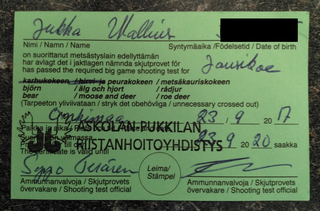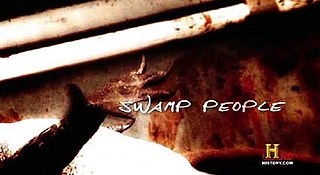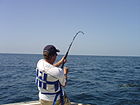Related Research Articles

Hunting is the human practice of seeking, pursuing, capturing, and killing wildlife or feral animals. The most common reasons for humans to hunt are to obtain the animal's body for meat and useful animal products, for recreation/taxidermy, although it may also be done for resourceful reasons such as removing predators dangerous to humans or domestic animals, to eliminate pests and nuisance animals that damage crops/livestock/poultry or spread diseases, for trade/tourism, or for ecological conservation against overpopulation and invasive species.

Game or quarry is any wild animal hunted for animal products, for recreation ("sporting"), or for trophies. The species of animals hunted as game varies in different parts of the world and by different local jurisdictions, though most are terrestrial mammals and birds. Fish caught non-commercially are also referred to as game fish.

The Kentucky Department of Fish and Wildlife Resources, an agency of the Kentucky Tourism, Arts and Heritage Cabinet, is responsible for the conservation of wildlife resources and for boating projects in the state. A commissioner appointed by the Fish and Wildlife Commission heads the department. The commission—which oversees the department's commissioner and promulgates regulations governing fishing, hunting, and boating—is a nine-member bipartisan board appointed by the governor from a list of candidates nominated by active hunters and anglers in each of nine geographic districts in the state.

Wildlife management is the management process influencing interactions among and between wildlife, its habitats and people to achieve predefined impacts. It attempts to balance the needs of wildlife with the needs of people using the best available science. Wildlife management can include wildlife conservation, gamekeeping and pest control. Wildlife management draws on disciplines such as mathematics, chemistry, biology, ecology, climatology and geography to gain the best results.

Game laws are statutes which regulate the right to pursue and hunt certain kinds of wild animals and fish. The scope of game laws can include the following:

Deer hunting is hunting deer for meat and sport, and, formerly, for producing buckskin hides, an activity which dates back tens of thousands of years. Venison, the name for deer meat, is a nutritious and natural food source of animal protein that can be obtained through deer hunting. There are many different types of deer around the world that are hunted for their meat. For sport, often hunters try to kill deer with the largest and most antlers to score them using inches. There are two different categories of antlers. They are typical and nontypical. They measure tine length, beam length, and beam mass by each tine. They will add all these measurements up to get a score. This score is the score without deductions. Deductions occur when the opposite tine is not the same length as it is opposite. That score is the deducted score.
The crossbow often has a complicated legal status due to its potential use for lethal purposes, and its similarities with both firearms and other archery weapons. The crossbow is, for legal purposes, often categorized as a firearm by various legal jurisdictions, despite the fact that no combustion is required to propel the projectile.

A hunting license or hunting permit is a regulatory or legal mechanism to control hunting, both commercial and recreational. A license specifically made for recreational hunting is sometimes called a game license.
A hunting season is the designated time in which certain game animals can be killed in certain designated areas. In the United States, each state determines and sets its own specific dates to hunt the certain game animal, such as California, in which they designate certain zones, in which each have their own separate dates in order to legally hunt.

The Alaska Department of Fish and Game (ADF&G) is a department within the government of Alaska. ADF&G's mission is to protect, maintain, and improve the fish, game, and aquatic plant resources of the state, and manage their use and development in the best interest of the economy and the well-being of the people of the state, consistent with the sustained yield principle. ADF&G manages approximately 750 active fisheries, 26 game management units, and 32 special areas. From resource policy to public education, the department considers public involvement essential to its mission and goals. The department is committed to working with tribes in Alaska and with a diverse group of State and Federal agencies. The department works cooperatively with various universities and nongovernmental organizations in formal and informal partnership arrangements, and assists local research or baseline environmental monitoring through citizen science programs.

Savage River State Forest is located in the north and northeastern part of Garrett County, in the U.S. state of Maryland. The state forest has many waterways, including Savage River Reservoir, which was built in 1952 by the U.S. Army. The dam was built as an emergency water supply for Washington, D.C. Savage River State Forest is known for its hunting, fishing, camping, and hiking trails.

Swamp People is an American reality television series that was first broadcast on History on August 22, 2010. The show follows the day-to-day activities of alligator hunters living in the swamps of the Atchafalaya River Basin who hunt American alligators for a living.
A slot limit is a tool used by fisheries managers to regulate the size of fish that can legally be harvested from particular bodies of water. Usually set by state fish and game departments, the protected slot limit prohibits the harvest of fish where the lengths, measured from the snout to the end of the tail, fall within the protected interval. For example, on a body of water where there is a protected slot limit on largemouth bass between 12 and 16 inches, largemouth between those lengths may not be harvested. In this example largemouth bass shorter than 12 inches (30 cm) and longer than 16 inches (41 cm) may be removed from the water and kept for personal use in accordance with local fishing regulations.
The Interstate Wildlife Violator Compact (IWVC) is a United States interstate compact to provide reciprocal sharing of information regarding sportsman fishing, hunting, and trapping violations and allows for recognition of suspension or revocation of hunting, fishing, and trapping licenses and permits in other member states resulting from violations concerning hunting, fishing and trapping laws in order to prevent poaching across state lines. All 50 US states are members of the compact.

The Rockefeller Wildlife Refuge is a large area of marshland in Cameron Parish and Vermilion Parish, Louisiana, United States. It was donated to the state with certain provisions as to its management as a wildlife sanctuary. It is a biodiverse habitat and is visited annually by many migratory birds. Much research is undertaken into marshland management and alligator ranching, and the income from the sale of alligators contributes to conservation of the marshland.

The fauna of Louisiana is characterized by the region's low swamplands, bayous, creeks, woodlands, coastal marshlands and beaches, and barrier islands covering an estimated 20,000 square miles, corresponding to 40 percent of Louisiana's total land area. Southern Louisiana contains up to fifty percent of the wetlands found in the Continental United States, made up of countless bayous and creeks.

Alligator meat is the meat from alligators that is for consumption. It has been used both historically and in contemporary times in various cuisines of the Southern United States. Alligator eggs can also be consumed. Alligator meat is high in protein and low in fat, and has a mild flavor and firm texture.

Alligator hunting is the capture and killing of gators. With the appropriate licenses and tags, the American alligator can legally be hunted in the Southeastern United States. The states of Florida, Georgia, Alabama, Arkansas, Mississippi, Louisiana, North Carolina, South Carolina, and Texas all distribute alligator hunting licenses.

Coon hunting is the practice of hunting raccoons, most often for their meat and fur. It is almost always done with specially bred dogs called coonhounds, of which there are six breeds, and is most commonly associated with rural life in the Southern United States. Coon hunting is also popular in the rural Midwest. Most coon hunts take place at night, with the dogs being turned loose, trailing and putting the raccoon up a tree without human assistance. Once the raccoon is in the tree, with the dog at the base, it is referred to as "treed", with "treeing" being the active verb form.

Hunting is a significant subsistence and recreational activity in the United States. Regulation of hunting began in the 19th century. Some modern hunters see themselves as conservationists. American hunting tradition values fair chase, which values the balance between the hunter and the animals. A 2006 poll showed that 78% of Americans support hunting. 6% of Americans have hunted. Hunting is most popular in the Midwest.
References
- ↑ Alligator Hunting Guides Archived 2012-01-22 at the Wayback Machine , Louisiana Alligator Advisory Council (retrieved 29 August 2010)
- ↑ Alligator Hunting: Louisiana, alligatorhunting.net (retrieved 29 August 2010)
- ↑ Alligators Rules and Regulations, Texas Parks and Wildlife Department (retrieved 29 August 2010)
- ↑ Kings Walk Shoot, retrieved 23/12/07 Archived 2007-12-21 at the Wayback Machine


